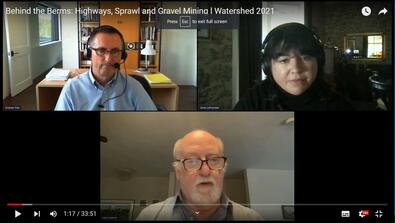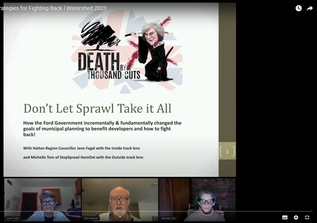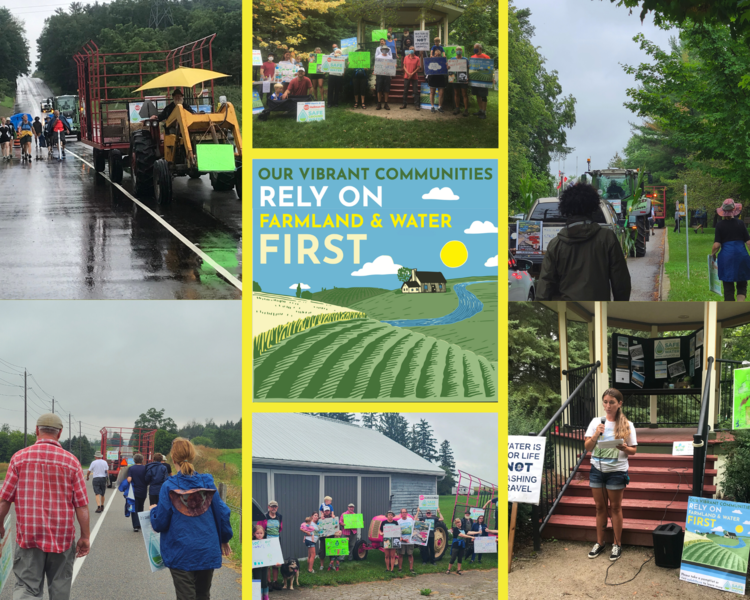Contact
![]()
 Rob Case, Social Development Studies, Renison University College
Rob Case, Social Development Studies, Renison University College
Introduction
The COVID-19 pandemic has been devastating for families and communities worldwide. In the nonprofit sector, advocates have had to find ways to adapt to meet public safety protocols, changing demands, resource limitations and shifting political contexts. Despite an abundance of freshwater resources, residents of southern Ontario, Canada have organized themselves to advocate on a variety of local, regional, and global issues related to water security and water justice. A leading organization in this context is the Wellington Water Watchers (WWW).
This study explores and expands on themes of crisis adaptation among nonprofit actors from evidence gathered among water advocacy groups. More specifically, the research documents and describes the impacts from, and adaptation to, COVID-19 on community organization and advocacy through a case study of the WWW at two different periods in the first year of the pandemic.
Methodology
In early 2020, WWW launched a campaign aimed at drawing water advocates together from across the region to build relationships, share strategies and strengthen efforts to engage communities in action. With the advent of COVID-19, plans for community-based, face-to-face events and activities leading up to an in-person “Watershed Summit” in the fall of 2020 suddenly became unviable and WWW was forced to shift gears. The study tracks this shift and assesses its implications for grassroots community organization.
The research is an exploratory, instrumental case study that comprised two stages of data collection. The first stage included 26 interviews with a diverse range of water advocates from across southern Ontario, conducted in the midst of adapting to the new realities of lockdowns and physical distancing, designed to identify priorities for water advocacy, approaches to water advocacy and impacts of COVID-19 on water advocacy efforts. The second round of data gathering included four semi-structured interviews with individual WWW personnel designed to gather retrospective perspectives on the impacts of COVID-19 on the organization, its campaigns and individual roles within the organization. A follow-up focus group with the four personnel together was then convened to clarify, test, and deepen themes emerging from the interviews, and to elicit perspective on the implications of COVID adaptation for ongoing organizing and campaign work.
The interviews and focus group were audio recorded and transcribed, and the data were collaboratively analyzed by three members of the research team using Dedoose online qualitative analysis software. Transcripts were analyzed using a four-step thematic analysis approach, beginning with open coding and identification of meaningful concepts, followed by axial coding identifying links and relationships between codes and themes to develop a coding scheme, developing and refining the coding scheme, and applying the final coding scheme to all transcripts.
Outcomes
The study found considerable resilience among the nonprofit water advocacy groups investigated and identified several key factors that underpinned it. Water advocates experienced significant disruption of plans and activities, particularly in the early stages of the pandemic, along with demoralizing concern about the future viability of their programs, campaigns, and organizations. In many cases, advocates took immediate precautionary measures and then settled into a period of reflection and regrouping as they waited for the implications for their organizations and programs to reveal themselves. The organizations whose programs suffered most were those with a focus on relationships built through in-person activities facilitated on the water, such as youth expeditions and overnight camps, for which no suitable on-line alternative existed.
In several contexts, participation in water advocacy activities increased during the first year of the pandemic. Part of the explanation could be related to the soul searching and a reevaluation of priorities that happened, for many people, in the wake of the pandemic’s onset, and to a consequent redirection of time and energy. WWW, in fact, experienced an increase in both revenues and demand for their support. Part of the explanation may be related to the relative affluence of the environmental movement’s supports, in combination with WWW’s efforts to remain active and visible in the early stages of the pandemic rather than withdraw and wait for more predictable times.
A key factor in maintaining activity levels and community engagement was the switch to digital tools and approaches. The shift undoubtedly discouraged some people from participating in water advocacy activities, however, the study illustrated how digital technologies can also facilitate engagement, involve new populations and create “new spaces” for protest. The findings suggest that the shift to digital approaches necessitated by the pandemic not only enabled groups like WWW to continue advocating for water protection and in some cases extend their reach, but also led to significant advances in the group’s core capacity for effective use of the digital space. Evidence also suggested that the disruption and “suspension of social routines” created conditions that made experimentation, innovation, the development of new capacities and the exploration of new strategic directions both necessary and acceptable.


Photo: (L) Online session supporting local campaigns fighting aggregate extraction and its water impacts. Mike Balkwill (Water Watchers, Campaign Director) and Graham Flint and Jenni Le Forestier. (R) Online session supporting Stop The Sprawl Hamilton's (Oct. 16, 2021): Mike Balkwill (Water Watchers, Campaign Director) and Michelle Tom & Jane Fogal.
The study found considerable desire among southern Ontario’s water advocates to take the disruption caused by the pandemic as an opportunity to assert broader and more transformative goals. Influenced by the momentum of Black Lives Matter and related networks, the articulation and commitment to an intersectional understanding of water justice gained unanticipated traction.
The experience of COVID-19 highlighted the importance of establishing contingency plans for a rapid shift in activities, and continuing to invest in digital advocacy capacity to strengthen the resilience in the face of future crisis. In addition, the research indicates that building and tending relationships both within and external to the organization is critical.
Conclusions
The degree to which the COVID-19 pandemic destabilized grassroots environmental advocacy groups and other nonprofits cannot be ignored. Facing uncertainty, southern Ontario’s water advocates took immediate precautionary measures, shifted whatever activities they could to online alternatives, and then paused to assess the implications and discern the best paths forward. After the initial shock of the pandemic, grassroots water organizations not only managed to adapt and maintain core functions, but evolved and in some cases even launched new approaches and initiatives. Fundamental to this adaptation, was the employment of digital tools and online approaches to organizing and advocacy; an openness within the organization and among their supporters to risk-taking and experimentation in the midst of the crisis; an organizational culture of open communication, cooperation and fluidity; and solid relationships with partners and leaders in the community. The disruption of normal routines also generated opportunities for asserting bolder visions and more ambitious goals.
Many of the pre-pandemic practices employed by community practitioners will return after the pandemic, but many of the new approaches adopted as emergency adaptation measures are likely to persist to augment traditional approaches or as new directions. Further experimentation and research could be helpful in delineating the specific limits of digital approaches in applying pressure and holding elected officials to account and in developing strategies to address those limits. Regardless, the research suggests that establishing an ongoing practice of using digital tools not only for the broadcast of information, but also to complement face-to-face approaches to relationship building and engagement, could both broaden impact and bolster resilience. Research specifically tracking the evolution of digital strategies used by social movement organizations and other non-profit actors could help in identifying best practices and specific limitations.

Photo: WW provides organizing, communications, and strategy support to Citizens for Safe Ground Water (CSGW) to put farmland and water first in Wilmot Township
Case, Robert, Eady, Allison (2022). Crisis and Opportunity: the impacts of COVID-10 on water advocacy in Ontario, Canada. Journal of Community Practice. DOI: 10.1080/10705422.2022.2103864
For more information about WaterResearch, contact Julie Grant.
Photo credits:
Banne Photo: Makasa Looking Horse and other Haudenosaunee land and water protectors, supported by the Water Watchers, delivers Cease & Desist order to Blue Triton bottling company, on behalf of the Haudenosaunee Confederacy (Sep. 2021)
Online session supporting Stop The Sprawl Hamilton's (Oct. 16, 2021): Mike Balkwill (Water Watchers, Campaign Director) and Michelle Tom & Jane Fogal. https://www.stopsprawlhalton.org/ Full recording here https://www.youtube.com/watch?v=NbW20sf-JVM
Online session supporting local campaigns fighting aggregate extraction and its water impacts. Mike Balkwill (Water Watchers, Campaign Director) and Graham Flint and Jenni Le Forestier. Full recording here https://www.youtube.com/watch?v=Igb0csGxnWY
WW provides organizing, communications, and strategy support to Citizens for Safe Ground Water (CSGW) to put farmland and water first in Wilmot Township: https://www.safeh2o.ca/






